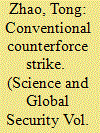| Srl | Item |
| 1 |
ID:
108152


|
|
|
|
|
| Publication |
2011.
|
| Summary/Abstract |
China and some other nuclear-armed countries have become concerned about the development and deployment of U.S. conventional global strike systems that may permit damage limitation operations against the nuclear forces of adversaries. This article argues that a counterforce strike is more likely to target tactical nuclear forces than intercontinental ballistic missiles and provides an analysis of the probability that U.S. conventional strikes might destroy China's theater nuclear forces which include DF-3A, DF-4, DF-21, DF-31 missiles, Type 094 nuclear submarines, and nuclear-capable H-6 bombers. The results indicate that China's strategy of building robust underground facilities may effectively protect its nuclear forces from preemptive strikes making it unlikely that a U.S. conventional strike could destroy a meaningful part of China's theater nuclear forces. This study also assesses the potential capabilities of future conventional prompt global strike systems, points out problems with the strategy of damage limitation, and proposes that the United States consider improving strategic stability in its relationship with China rather than threatening a preemptive strike.
|
|
|
|
|
|
|
|
|
|
|
|
|
|
|
|
| 2 |
ID:
108154


|
|
|
|
|
| Publication |
2011.
|
| Summary/Abstract |
There is growing interest in a set of methods and tools that can be used to characterize past fissile material production activities, using measurements and sampling at production and storage sites. This field has been dubbed "nuclear archaeology." The best-established example of nuclear archaeology relies on measurements of the isotope ratios of selected elements in the graphite of graphite-moderated plutonium production reactors. This Graphite Isotope-Ratio Method (GIRM) determines the cumulative neutron fluence through the graphite and thereby estimates the cumulative plutonium production in the reactor. The great limitation of this particular method is that it can only be applied to graphite-moderated reactors, which represent only one class of reactors that have been used for unsafeguarded plutonium production. In this article, we propose to extend this method to non-graphite moderated reactors by analyzing the evolution of relevant isotope ratios in the support structures and other core components of heavy-water moderated reactors. We present results of neutronics calculations for a generic heavy-moderated reactor evaluating the robustness of the method and explore the role of nuclear archaeology for applications in arms-control treaty verification.
|
|
|
|
|
|
|
|
|
|
|
|
|
|
|
|
| 3 |
ID:
108151


|
|
|
|
|
| Publication |
2011.
|
| Summary/Abstract |
Nuclear exchange models using Monte Carlo methods were used to test the stability of U.S.-Russian deterrence for reduced nuclear force sizes off alert in the presence of missile defenses. For this study U.S. and Russian weapons were partitioned into a postulated First Echelon, consisting of single-warhead, silo-based ICBM launchers that can be generated in hours to launch-ready status, and into a postulated Second Echelon of more diverse nuclear forces including multiple-warhead, road-mobile and sea-based systems that require days to weeks to become launch ready. Given reasonable estimates of weapons characteristics, First Echelon nuclear forces can survive to retaliate in numbers that satisfy the requirements of deterrence, given limitations on the numbers of missile defense interceptors, a result which is bolstered by the added capabilities of the more deeply de-alerted Second Echelon.
|
|
|
|
|
|
|
|
|
|
|
|
|
|
|
|